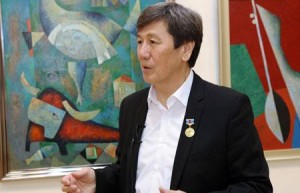 ASTANA – A jubilee exhibition of Sultan Ilyaev’s “Repetition” is being held in the capital’s Museum of Modern Art.
ASTANA – A jubilee exhibition of Sultan Ilyaev’s “Repetition” is being held in the capital’s Museum of Modern Art.
Ilyaev was born in 1954 to a family of the arts. His father Gani Ilyaev collected and studied Kazakh ornaments, so choosing a career when the time came was not difficult for him. In 1977, Ilyaev graduated from the graphic arts faculty of Shymkent State Pedagogical Institute and began working as a teacher at the Kasteyev Art School. He participated in national and international exhibitions and his works are housed in museums in Almaty, Moscow, Tashkent, Sochi and in private galleries in different countries. Now, Ilyaev is chief art expert for the city of Shymkent and chairman of the Artists’ Union of Kazakhstan.
Many of his works are monuments and mosaics. For example, “Zhibek Zholy” (Silk Way) complex in South Kazakhstan’s ancient city of Sairam reflects the national identity and the “Altyn Agash” (Golden Tree) composition amazes with its scale and expressiveness.
Sultan Ilyaev has created the following monuments: Akpan Batyr and Sabir Rakhimov in Shymkent, Kabanbay Batyr in Turkestan, and Kulager in the Akmola region.
In Astana, where his works are being exhibited for the first time, he presented his paintings and graphics from 2011-2013.
His creative works are distinguished by their decorative brushwork, clean bright colours, allegory and capacious repeating images including the horse, fish and bird which symbolize the elements; the house, shanyrak, tree, woman, cradle and dombra kobyz.
They form the original formula of life and are closely related to ancient ideas about the world and traditions. Kazakhs are taught these things during childhood and can understand a series of transformations, mappings and interpretations, which form the constants of existence.
No less important in his works are the ornamental undertones. Ilyaev recalls his father’s words that, every Kazakh ornament carries coded information. The viewer is directly involved in the answer to these “codes” of Ilyaev: his “Oasis” work helps one understand how to feel happiness, while “House under the Sun,” “Aul,” “Cradle,” “In the Shade of a Tree” converge to create a great melody like the one that is born when musicians touch the strings of the kobyz and dombra.


